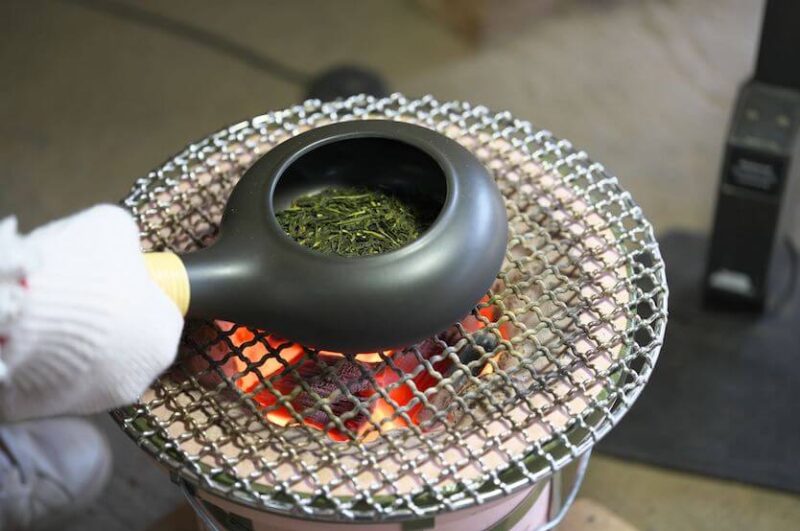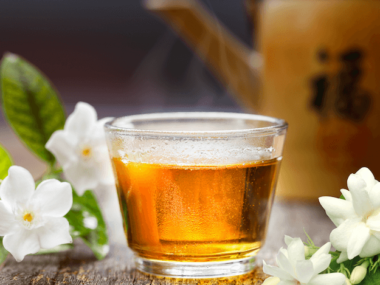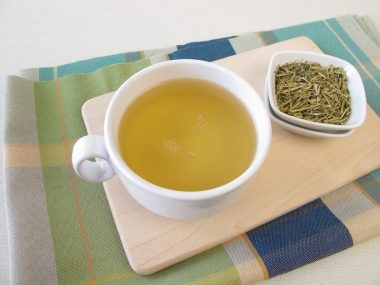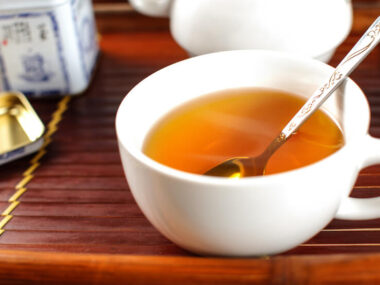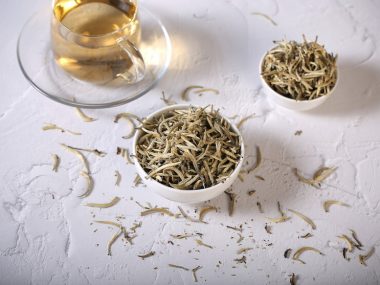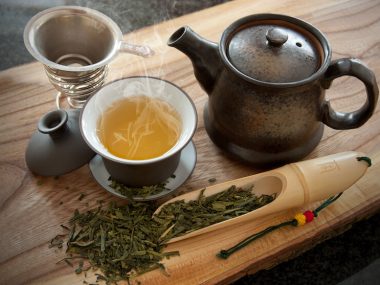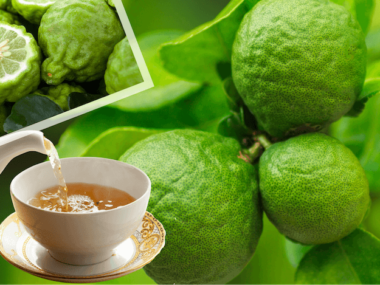Try and imagine yourself sitting next to a campfire, and the sound of the crackle and the smell of the burning wood carries you away. What if we told you that the whole campfire experience could be found in a cup of tea? That is a cup of hojicha tea!
Table of Contents
What Is Hojicha Tea?
Hojicha tea was developed by using leftover scraps of tea plant leaves and stems grown for green teas in Japan. “Hojicha” is a term that refers to roasting these leftover scraps rather than a particular plant name. These leftovers typically come from green tea plants, used to produce other tea blends.
So, is hojicha black tea or green tea? Hojicha is a green tea because it comes from parts of the green tea plant Camellia sinensis var. sinensis. The plant is grown to produce other green tea varieties such as sencha, genmaicha, guricha, or konacha. These specific teas come from tea plants planted in direct sun (known as ‘bancha.’)
How Hojicha Tea Came To Be
The beauty of Japanese culture is the resourcefulness that goes into producing new foods. Being wasteful is not something you’ll likely find in Japan, especially when it comes to the tea industry.
Hojicha tea is a perfect example of this principle. About 100 years ago, one man took the “scraps” of tea plants (stems, leaves, stalks, twigs) to try a new method of processing tea. Instead of steaming and drying the leaves, he roasted the plant scraps over a charcoal fire. The results were aromatically pleasant. However, the taste astonishingly wonderful. This method of roasting tea became known as “Hojicha.” A new tea had been born!
Processing Of Hojicha Tea
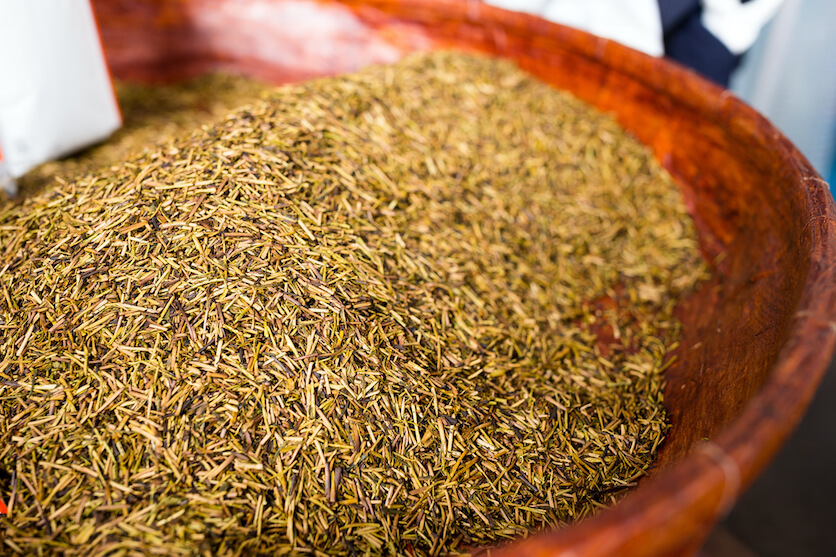
Hojicha undergoes different roasts to produce certain flavors. Roasting plays a role in the reduction of caffeine and bitterness that tea generally has. Hojicha is smooth, much less bitter, and lower in caffeine. Harvests of the plant “scraps” occur in May-June.
The Different Roasts Of Hojicha Tea
Each roast has its own flavor and aroma as well as harvest time.
- Classic Roast
- Harvested in June
- The original aroma, enjoyed for the past 100 years.
- Processing: steamed, rolled, dried, roasted
- Dark Roast
- Harvest in June
- Aroma: earthy
- Processing: steamed, rolled, dried, roasted
- Gold Roast
- Considered the “Cadillac” of Hojicha tea
- Harvested in May
- Aroma: smoky
- Processing: steamed, rolled, dried, roasted
- Powder
- Used for lattes, teas, and desserts
- Processing: steamed, rolled, dried, roasted, grounded
What Does Hojicha Taste Taste Like?
The first thing hojicha tea drinkers will tell you is this tea tastes smoky and sweet. Some have even referred to it as the essence of a campfire in a cup of tea. That alone makes this tea worth exploring if you haven’t tried it.
So, does hojicha taste like regular green tea? Green teas often have earthy, grassy, vegetal notes. However, you won’t find this in hojicha. The smoky aroma and flavor punch through fooling your senses because of the expectation of it being a green tea; it’s going to taste like a green tea.
Flavor Profiles Of The Different Roasts
- Classic Roast: smoky, sweet
- Dark Roast: smoky, sweet
- Gold Roast: smoky, umami
- Powder: hints of cocoa, earthy
Roasting the tea removes any bitterness in the tea, which gives you a very smoky, sweet tea. The tea is sweet enough to stand on its own with added sweeteners. When enjoying hojicha, it’s best not to brew your tea with water over 175 degrees (F), or the smoky flavor is intensified.
How Is Hojicha Cultivated and Processed?
Hojicha tea comes from tea plants cultivated in tea gardens in and around Kyoto, Japan. These tea plants go through several harvests (also known as flushes.) Hojicha comes from the lower part of the tea plant (called bancha) and is harvested in the last flush in autumn.
This tea is referred to as “scrappy” or made from leftover tea plants used for other teas. This basically references what’s leftover from the previous flushes in this last flush. The last flush (harvest) is done by hand, as are all flushes.
The leaves/stems are steamed within 12-20 hours after being picked. This is to prevent oxidation. Next, the leaves/stems go to be rolled. Rolling (using a twisting motion) causes the fibers of the leaves and stems to soften. Once this is completed, they are dried to remove moisture.
Sorting is the next step where large wicker/bamboo trays are used to toss the dried leaves/stems to sort the bigger pieces from the smaller ones. The large stems and coarse leaves are used for hojicha, and the rest goes on to produce other teas.
Roasting is the next and final step in processing the leaves/stems. Roasting takes place in what looks like large earthenware pots built over charcoal fires. As the leaves/stems are heated, the smoky aroma fills the air. During this process, the caffeine is significantly reduced. The end result is brown, fragrant roasted tea.
This tea now goes on to tea manufacturers who either grind it up for powder form or package it as a loose leaf.
How Much Caffeine Is In Hojicha Tea?
If there ever was a true tea that’s very low in caffeine, this one’s it. Hojicha tea has about 7.7mg of caffeine per 6 ounces. Compared to black tea, which packs in up to 50mg of caffeine per 6 ounces, Hojicha is indeed something to be enjoyed any time of the day. This tea contains L-Theanine and pyrazines, which actually relaxes rather than cause the jitters.
What Is The Difference Between Hojicha and Matcha?
Hojicha powder may be mistaken as a matcha tea because of its greenish appearance. Matcha is also a powder made from tea leaves. However, the distinguishing difference is in aroma and flavor. Matcha will be earthy, grassy, and vegetal in aroma and flavor, whereas hojicha is smoky in aroma and flavor and sweet. When brewed, matcha will still be a vibrant green color; however, hojicha is amber-colored.
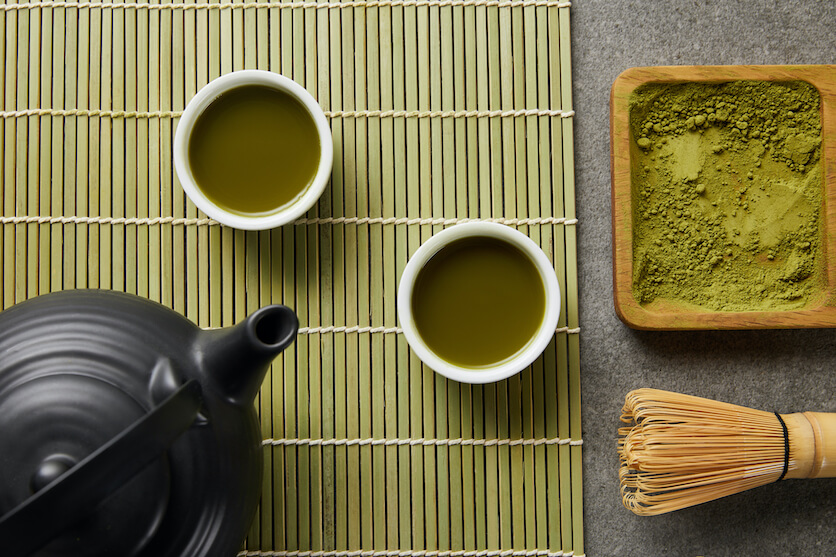
Is It Okay To Drink Hojicha Tea Every Day?
You bet it is! Green tea is highly beneficial to consume daily. Hojicha is low enough in caffeine that you really never need to be concerned unless you were to drink almost 52 6-oz. Cups of this tea. Each six-ounce cup only contains 7.7mg of caffeine. The daily recommended intake of caffeine is 400mg or less.
Hojicha Tea Benefits
Green tea is chocked full of health benefits that cover us from head to toe. Enjoying a cup of tea daily, you build a healthy defense for a host of medical conditions, diseases, viruses, and bacteria.
Offers Tea Drinkers A Low-Caffeine Alternative
For tea drinkers who are caffeine sensitive, hojicha offers a very low caffeine way to enjoy the benefits of green tea without high caffeine content. An average 6 oz. cup of green brewed tea contains about 3.5mg of caffeine per ounce which comes to a total of 21mg. A 6 oz. cup of hojicha tea is 7.7mg of caffeine. By opting for hojicha tea, you consume only about 8% of the caffeine of the same size as a cup of green tea.
Antiviral
Green tea contains compounds called polyphenols and catechins. By drinking green tea (which includes hojicha), our body highly benefits from these compounds because they boost our immune system helping us to fight viruses such as Hepatitis C, Herpes Simplex, flu, HIV-1 (aids,) and enteroviruses. So, by drinking hojicha tea, your immunity arms itself against the next cold, respiratory infection, or worse, flu.
Dental Health
Green tea contains four catechins (epicatechin gallate, epicatechin, epigallocatechin, epigallocatechin gallate) that not only protect our teeth and gums but prevent gum disease. These catechins prevent bacterial growth (P. gingivalis, Prevotella intermedia, Prevotella nigrescens) from adhering to our teeth and gums. Polyphenols in the tea also prevent gum disease and attack halitosis (bad breath), acting as a deodorizer.
How To Brew Hojicha Tea
You will find that a fresh brew of hojicha tea offers a two-fold sensory surprise. The smoky aroma and smoky-sweet flavor tickle the nose and the palate.
Hojicha Earthy Infusion Latte
Ingredients
- ½ cup of ice
- 1 teaspoon of green matcha powder
- ½ cup of cold water
- 1 cup of milk
- 2 teaspoons of hojicha powder
- ⅛ teaspoon of light brown sugar (optional)
Directions
- Pour ½ cup of ice into a glass
- Whisk the 1 teaspoon of matcha powder and 3 tablespoons of cold water together.
- Pour over the ice.
- Pour the milk slowly over the ice and matcha.
- Whisk 2 teaspoons of hojicha powder and 5 tablespoons of cold water together.
- Slowly pour over the milk.
- You will notice a swirl of layered colors of greens and browns begin to form.
- Insert a straw and enjoy!
Tip: To add “wow factor,” top your latte with a dollop of whipped cream and a tad of chocolate syrup.
Traditional Brewed Hojicha
Ingredients
- 1 teaspoon of loose leaf hojicha tea
- 8 oz. of water
Directions
- Boil water until it reaches 175 degrees (F.)
- Place loose leaf tea in an infuser and drop it into a teacup.
- Pour water into the teacup and allow to steep for 1 minute.
- Add sweetener if desired.
- Enjoy!
Hojicha Is A Swell Tea
We encourage you to try hojicha if you haven’t. It makes a perfect drink to enjoy on those days when the chill settles to the bone. The smoky aroma and flavor will transport you to a warm campfire where your toes are warm, and the crackle of the fire calms.
